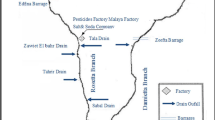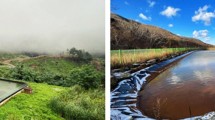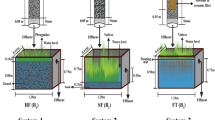Abstract
The present investigation demonstrates the synergistic action of using a sedimentation unit together with Cyperus papyrus (L.) wetland enriched with zeolite mineral in one-year round experiment for treating wastewater. The system was designed to support a horizontal surface flow pattern and showed satisfactory removal efficiencies for both physicochemical and bacteriological contaminants within 3 days of residence time. The removal efficiencies ranged between 76.3% and 98.8% for total suspended solids, turbidity, iron, biological oxygen demand, and ammonia. The bacterial indicators (total and fecal coliforms, as well as fecal streptococci) and the potential pathogens (Escherichia coli, Staphylococcus aureus, and Pseudomonas aeruginosa) showed removal efficiencies ranged between 96.9% and 99.8%. We expect the system to offer a smart management for every component according to zero waste principle. The treated effluent was reused to irrigate the landscape of pilot area, and the excess sludge was recycled as fertilizer and soil conditioner. The zeolite mineral did not require regeneration for almost 36 weeks of operation, and enhanced the density of shoots (14.11%) and the height of shoots (15.88%). The harvested plant biomass could be a profitable resource for potent antibacterial and antioxidant bioactive compounds. This could certainly offset part of the operation and maintenance costs and optimize the system implementation feasibility. Although the experiment was designed under local conditions, its results could provide insights to upgrade and optimize the performance of other analogous large-scale constructed wetlands.

Similar content being viewed by others
References
Al-Samarrai G, Singh H, Syarhabil M (2012). Evaluating eco-friendly botanicals (natural plant extracts) as alternatives to synthetic fungicides. Annals of Agricultural and Environmental Medicine, 19(4): 673–676
Al-Tameme H J, Hameed I H, Idan S A, Hadi M Y (2015). Biochemical analysis of Origanum vulgare seeds by Fourier-transform infrared (FT-IR) spectroscopy and gas chromatography-mass spectrometry (GC-MS). Journal of Pharmacognosy and Phytotherapy, 7(9): 221–237
Ambrozova P, Kynicky J, Urubek T, Nguyen V D (2017). Synthesis and modification of clinoptilolite. Molecules (Basel, Switzerland), 22(7): 1107–1119
APHA (2012). Standard Methods for the Examination of Water and Wastewater. Vol. 22, 22nd ed. Washington, DC: American Public Health Association
Arden S, Ma X (2018). Constructed wetlands for grey water recycle and reuse: A review. Science of the Total Environment, 630: 587–599
Avery B, Bascomb C (1982). Soil Survey Laboratory Methods. Harpenden (UK): Soil Survey of England and Wales
Ayers R S, Westcot D W (1985). Water Quality for Agriculture. Vol. 29. Rome. Food and Agriculture Organization of United Nations
Cairo P C, Armas J M, Artiles P T, Martin B D, Carrazana R J, Lopez O R (2017). Effects of zeolite and organic fertilizers on soil quality and yield of sugarcane. Australian Journal of Crop Science, 11(06): 733–738
Civilini M (2009). Identification and characterization of bacteria isolated under selective pressure of volatile organic compounds. Journal of Environmental Biology, 30: 99–105
Devi R B, Barkath T N, Vijayaraghavan P, Rejiniemon T S (2018). GC-MS analysis of phytochemical from Psidium guajava Linn leaf extract and their in vitro antimicrobial activities. International Journal of Pharma and Bio Sciences, 8(1): 583–589
Falowo A B, Muchenje V, Hugo A, Aiyegoro O A, Fayemi P O (2017). Antioxidant activities of Moringa oleifera L. and Bidens pilosa L. leaf extracts and their effects on oxidative stability of ground raw beef during refrigeration storage. CYTA: Journal of Food, 15(2): 249–256
Foo L W, Salleh E, Hana S N (2017). Green extraction of antimicrobial bioactive compound from piper betle leaves: Probe type Ultrasound-assisted extraction vs supercritical carbon dioxide extraction. Chemical Engineering Transactions, 56: 109–114
Gherraf N, Zellagui A, Kabouche A, Lahouel M, Salhi R, Rhouati S (2017). Chemical constituents and antimicrobial activity of essential oils of Ammodaucus leucotricus. Arabian Journal of Chemistry, 10 (52): S2476–S2478
Ghimire U, Nandimandalam H, Martinez-Guerra E, Gude V G (2019). Wetlands for wastewater treatment. Water Environment Research, 91 (10): 1378–1389
Haichar F Z, Santaella C, Heulin T, Achouak W (2014). Root exudates mediated interactions belowground. Soil Biology & Biochemistry, 77: 69–80
Hassanein H D, Nazif N M, Shahat A A, Hammouda F M, Aboutable E S A, Saleh M A (2014). Chemical diversity of essential oils from Cyperusarticulatus, Cyperus esculentus and Cyperus papyrus. Journal of Essential Oil Bearing Plants, 17(2): 251–264
Hedström A (2001). Ion exchange of ammonium in zeolites: A literature review. Journal of Environmental Engineering, 127(8): 673–681
Kadir K, Nelson K L (2014). Sunlight mediated inactivation mechanisms of Enterococcus faecalis and Escherichia coli in clear water versus waste stabilization pond water. Water Research, 50: 307–317
Kadlec R H, Knight R L (1996). Treatment Wetlands. Boca Raton: Lewis-CRC Press
Kansiime F, Saunders M J, Loiselle A S (2007). Functioning and dynamics of wetland vegetation of Lake Victoria: An overview. Wetlands Ecology and Management, 15(6): 443–451
Kaushal M, Patil M D, Wani S P (2018). Potency of constructed wetlands for deportation of pathogens index from rural, urban and industrial wastewater. International Journal of Environmental Science and Technology, 15(3): 637–648
Kyambadde J, Kansiime F, Gumaelius L, Dalhammar G (2004). A comparative study of Cyperus papyrus and Miscanthidium violaceum-based constructed wetlands for wastewater treatment in a tropical climate. Water Resources, 38: 475–485
Lamastra L, Suciu N A, Trevisan M (2018). Sewage sludge for sustainable agriculture: contaminants’ contents and potential use as fertilizer. Chemical and Biological Technologies in Agriculture, 5(1): 10–15
Leal C, Val del Río A, Mesquita D P, Amaral A L, Castro P M L, Ferreira E C (2020). Sludge volume index and suspended solids estimation of mature aerobic granular sludge by quantitative image analysis and chemometric tools. Separation and Purification Technology, 234: 116049
Levesque R (2007). SPSS Programming and Data Management. A Guide for SPSS and SAS Users, 4th ed, Chicago (IL): SPSS, 522 P
Lu S, Pei L, Bai X. (2015). Study on method of domestic wastewater treatment through new-type multi-layer artificial wetland. International Journal of Hydrogen Energy, 40(34): 11207–11214
Malekian R, Abedi-Koupai J, Eslamian S (2011). Influences of clinoptilolite and surfactant-modified clinoptilolite zeolite on nitrate leaching and plant growth. Journal of Hazardous Materials, 185(2–3): 970–976
Maltais-Landry G, Chazarenc F, Comeau Y, Troesch S, Brisson J (2007). Effects of artificial aeration, macrophyte species, and loading rate on removal efficiency in constructed wetland mesocosms treating fish farm wastewater. Journal of Environmental Engineering and Science, 6(4): 409–414
Marín-Muñiz J L, García-González M C, Ruelas-Monjardín L C, Moreno-Casasola P (2018). Influence of different porous media and ornamental vegetation on wastewater pollutant removal in vertical subsurface flow wetland microcosms. Environmental Engineering Science, 35(2): 88–94
McHenry J, Werker A (2005). In-situ monitoring of microbial biomass in wetland mesocosms. Water Science and Technology, 51(9): 233–241
Mnaya B, Asaeda T, Kiwango Y, Ayubu E (2007). Primary production in papyrus (Cyperus papyrus L.) of Rubondo Island, Lake Victoria, Tanzania. Wetlands Ecology and Management, 15(4): 269–275
Penduka D, Buwa L, Mayekiso B, Basson A K, Okoh A I (2014). Identification of the anti Listerial constituents in partially purified column chromatography fractions of Garcinia kola seeds and their interactions with standard antibiotics. Evidence-Based Complementary and Alternative Medicine, 2014: 1–8
Perbangkhem T, Polprasert C (2010). Biomass production of papyrus (Cyperus papyrus) in constructed wetland treating low-strength domestic wastewater. Bioresource Technology, 101(2): 833–835
Perez C, Pauli M, Bazerque P (1990). An antibiotic assay by agar well diffusion method. Acta Biologiae et Medicinae Experimentalis, 15: 113–115
Polat E, Karaca M, Demir H, Onus A (2004). Use of natural zeolite (Clinoptilolite) in agriculture. Journal of Fruit and Ornamental Plant Research, 12: 184–189
Prakash A, Suneetha V (2014). Punica granatum (Pomegranate) rind extract as a potent substitute for L-ascorbic acid with respect to the antioxidant activity. Research Journal of Pharmaceutical, Biological and Chemical Sciences, 5(2): 597–603
Rhodes C J (2010). Properties and applications of zeolites. Science Progress, 93(3): 223–284
Rivera-Garza M, Olguín M T, García-Sosa I, Alcántara D, Rodríguez-Fuentes G (2000). Silver supported on natural Mexican zeolite as an antibacterial material. Microporous and Mesoporous Materials, 39 (3): 431–444
Song Q, Li J, Zeng X (2015). Minimizing the increasing solid waste through zero waste strategy. Journal of Cleaner Production, 104: 199–210
Susarla S, Medina V F, McCutcheon C (2002). Phytoremediation: An ecological solution to organic chemical contamination. Ecological Engineering, 18(5): 647–658
Taha A S, Salem M Z M, Abo Elgat W A A, Ali H M, Hatamleh A A, Abdel-Salam E M (2019). Assessment of the impact of different treatments on the technological and antifungal properties of papyrus (Cyperus papyrus L.) Sheets. Materials (Basel), 12(4): 620–638
Terer T, Triest L, Muthama Muasya A (2012). Effects of harvesting Cyperus papyrus in undisturbed wetland, Lake Naivasha, Kenya. Hydrobiologia, 680(1): 135–148
Timotewos M T, Kassa K, Reddythota D (2017). Selection of mesocosm to remove nutrients with constructed wetlands. Journal of Ecological Engineering, 18(4): 42–51
Trepel M, Palmeri L (2002). Quantifying nitrogen retention in surface flow wetlands for environmental planning at the landscape scale. Ecological Engineering, 19(2): 127–140
Turk M, Bayram G, Budakli E, Celik N (2006). A study on effects of different mixtures of zeolite with soil rates on some yield parameters of Alfalfa (Medicago sativa L.). Journal of Agronomy, 5(1): 118–121
Verma R, Suthar S (2018). Performance assessment of horizontal and vertical surface flow constructed wetland system in wastewater treatment using multivariate principal component analysis. Ecological Engineering, 116: 121–126
Vymazal J (2011). Plants used in constructed wetlands with horizontal subsurface flow: A review. Hydrobiologia, 674(1): 133–156
Wang S, Peng Y (2010). Natural zeolites as effective adsorbents in water and wastewater treatment. Chemical Engineering Journal, 156(1): 11–24
Wang Y F, Lin F, Pang W Q (2007). Ammonium exchange in aqueous solution using Chinese natural clinoptilolite and modified zeolite. Journal of Hazardous Materials, 142(1–2): 160–164
WHO (2006). Guidelines for the Safe Use of Wastewater, Excreta and Greywater. Geneva: World Health Organization
Widiastuti N, Wu H, Ang M, Zhang D (2008). The potential application of natural zeolite for greywater treatment. Desalination, 218(1–3): 271–280
Yang Y, Zhao Y, Liu R, Morgan D (2018). Development of various emerged substrates utilized in constructed wetlands. Bioresource Technology, 61: 441–452
Zamora S, Marín-Muñíz J L, Nakase-Rodríguez C, Fernández-Lambert G, Sandoval L (2019). Wastewater treatment by constructed wetland eco-technology: Influence of mineral and plastic materials as filter media and tropical ornamental plants. Water (Basel), 11(11): 2344–2355
Acknowledgements
The authors wish to express their gratitude to the Microbiology Dep., Central Laboratory for Environmental Quality Monitoring (CLEQM), National Water Research Center (NWRC) in Egypt for supporting this work. The authors would like also to thank Mr. Kyle Bowman, Head Bioelectrochemical Engineer at Wase-tech, London, UK for his language editing revision of the manuscript.
Author information
Authors and Affiliations
Corresponding author
Additional information
Data Availability Statement
Data are available upon request from the author at: dr-safaa-ezzat@hotmail.com.
Highlights
• Smart wetland was designed to treat wastewater according to zero waste principle.
• The system included a dynamic roughing filter, Cyperus papyrus (L.) and zeolite.
• It removed 98.8 and 99.8% of chemical and bacterial pollutants in 3 days.
• The effluent reused to irrigate a landscape and the sludge recycled as fertilizer.
• The plant biomass is a profitable resource for antibacterial and antioxidants.
Rights and permissions
About this article
Cite this article
Ezzat, S.M., Moustafa, M.T. Treating wastewater under zero waste principle using wetland mesocosms. Front. Environ. Sci. Eng. 15, 59 (2021). https://doi.org/10.1007/s11783-020-1351-9
Received:
Revised:
Accepted:
Published:
DOI: https://doi.org/10.1007/s11783-020-1351-9




